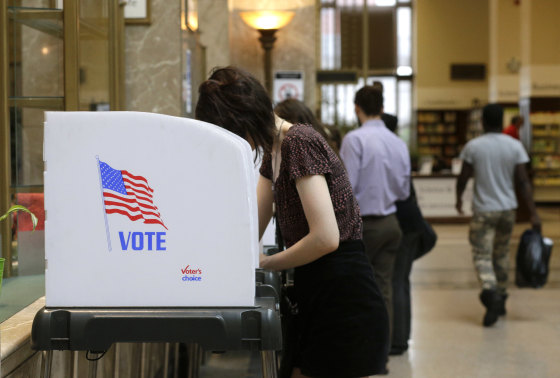The question over how Latinos voted on Election Day is not going away. The national exit polls on Election Night found Donald Trump got 29 percent of the Latino vote, more than Mitt Romney got in 2012 (he got 27 percent according to exit polls.)
The findings differ markedly from an election eve poll by the polling firm Latino Decisions, which found only 18 percent of Hispanics said they were voting for Donald Trump. (Latino Decisions' main principals, Matt Barreto and Gary Segura, did polling for the Clinton campaign but were not involved in the election eve poll).
Since then, the question of who's closer to the truth has generated a lot of activity from well-known pollsters and journalists, from FiveThirtyEight to the Washington Post to Univision.
It's also led to calls from Latino Democrats in Congress to provide more accurate information about the polls. Rep. Xavier Becerra, D-Calif., chairman of the House Democratic Caucus, said in a statement that the media has an obligation to present to the public the most accurate information possible. "How could the exit polling and the media get it so wrong?" he asked.
This is not the first time that several Latino pollsters have clashed over the exit polls, which are conducted by Edison Research and used by many media entities, including NBC News. This was an issue in 2004 with debate over whether George W. Bush won 44 percent of the vote and in 2014 over the results of the midterm elections in Texas.
We will get more information in the next few months about the 2016 vote, but as Latinos continue to grow as an electoral group, perhaps the best thing is to focus on the next national elections and how we can assure that polling accurately reflects the Hispanic vote.
Here's two ways to improve polling:
Ensure Latino diversity is represented in sample group
Latinos who participate in the exit poll, called a sample, must "look" like the people the sample represents. Researchers break up people into categories called variables to help understand their experiences.
Ensuring the right distribution of Hispanics by education, income, country of origin, generation, language and geographic region, etc. are important because social science has found them to be influential over the political opinions they have.
RELATED: Who Got the Latino Vote Right?
Essentially, if the people in the sample don't match the population they represent, the poll won't show an accurate picture.
For instance, about 60 percent of Latino voters trace their ancestry to Mexico; is this reflected in the sample? Similarly, the voting sample should reflect the national share of other groups like Puerto Ricans and Cubans.
Almost half of Latinos live in neighborhoods in which the residents are majority Hispanic. The Latino respondents participating in the exit poll should match this as closely as possible.
According to the U.S. Census, about 30 percent of Latinos are Spanish-dominant speakers. This too should be represented in the participants of the poll.
Provide data that verifies results
Second, once the poll is out, people should know the demographics of the sample and it should be provided in a timely manner.
Currently, there's not much information about the breakdown of Latinos in the exit poll sample. In the 2016 exit polls, for example, some media entities showed graphs where only one Latino age group voted 29 percent for Trump; the rest were at a lower share. So how did we reach 29 percent for the total Latino vote?
These discrepancies could be rectified if more information were given out along with the exit poll results.
The public should have access to information that any researcher is required to disclose when publishing results from their data. This would show whether the Latino sample is indeed representative of the group's diversity among the population at large.
It is important to understand here that what the researchers wish the results to be, politically, is irrelevant. As a pollster, it would be fascinating if Trump garnered 29 percent of the Latino vote. But when there are so many unanswered questions about the data, we can't say that the exit polls accurately measured the true Latino vote, despite the widespread amplification of the results.
Why it matters
Exit polls are presented on Election Day to the public to help predict what is happening and to help us understand why people voted the way they did. This not only helps the country understand the problems and issues it faces, but it's also instructive for those elected to represent them.
As the Latino population grows, understanding the community is important for everyone. Earlier this year, there were concerns by organizations that the Democrats were not properly investing in voter outreach within the Latino community. Polls helped the parties and the community understand what was going on in real time; it was through surveys that the parties and the community were able to understand each other.
Journalists have long seen their role of reporting election results as providing a public good. Since media companies pay for and use exit poll information, it's incumbent on the press as well as pollsters to be as accurate and clear as possible about the growing Latino electorate.
*Disclosure: The author, political scientist Stephen Nuño, has worked with Latino Decisions in the past.

